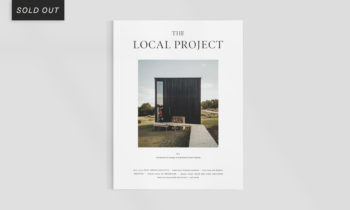A Graceful Unity of Old and New - Chamfer House by Ha Architecture
The Fisher & Paykel Series
Brunswick, VIC, Australia

Nestled deferentially behind a double-storey Victorian terrace, the Chamfer House by Ha Architecture gracefully addresses the inherent challenges of its restricted site and heritage context.
Set in the middle of a row of terraces, the Chamfer House suffered from a complete absence of natural light in the centre of the building, while planning and heritage restrictions created a challenge for the new addition. “New policy meant no overshadowing of our neighbours’ private open space was permitted if it was less than 40m. City of Moreland was very tough on the proposal, and we worked hard to provide a proposal that responded to the clients’ brief while not overshadowing the neighbours,” Nick Harding, Ha Architecture principal, explains. “The ‘chamfer’ and the dramatic skillion form of the guest bedroom above was our design response to shadowing studies and what was most effective.”
With the original street-facing facade occupying the valuable northern aspect, the new addition to the rear was left to face south, adding another challenge to the clients’ brief for a home filled with natural light. In the absence of the ability to bring direct sunlight into the building, a lightwell garden placed at the threshold point between old and new and a skylight adjacent to the lightwell achieve a soft diffusion of light throughout the spaces. Glazed on all sides, the lightwell garden creates a small pocket through which the study is visually connected the living area, as well as providing natural light and a natural outlook, an important consideration given the client, a barrister, works into the evening at home and requested a functional study in the brief.
“The ‘chamfer’ and the dramatic skillion form of the guest bedroom above was our design response to shadowing studies and what was most effective.”
“The lightwell provides cross ventilation along the length of the living room, which is essential to a row house,” says Nick. “The bespoke steel window frames were made by a steelworker who doesn’t typically do windows,” he continues, “so they added a refined elegance, typical of the original house’s era.” This fine, handcrafted charcoal steel framing is taken up again with the south-facing facade’s expanse of the glazing. The rear span of steel-framed windows, combined with the delicate insertion of the lightwell in the home’s centre, contributes to an atmosphere reminiscent of a 19th-century orangery that creates an impression of more light than the southern orientation would ordinarily allow.
The interior is further lightened by the simple, predominantly white, palette, which serves to unite the old and new in the design. “We generally try to work with honest materials,” says Nick, “here, the simplicity of a white-painted brick Victorian house creates a continuity between old and new. White unites the original and new sections, although it is inevitable that an extension results in a collage of materials.” Where white lightens and simplifies the space, timber is used to define functional zones, a move that allows much of the home’s functionality to be hidden and integrated within joinery.
“The lightwell provides cross ventilation along the length of the living room, which is essential to a row house.”
“Joinery is an opportunity to make a functional solution look beautiful,” says Nick. “Typical of any inner-city house, every square metre of the Chamfer House had to be functional, and timber visually transforms it into a design aspect”. The kitchen is in the centre of the home and also acts as the laundry and the home’s general storage. Tasmanian oak joinery creates a consistent visual line across one wall, before dropping down to form a shelf that functions as a hearth in the living space, while the television is concealed by a sliding panel to create a quiet and unified aesthetic.
An integrated refrigerator by Fisher & Paykel, as well as a stacked washer and heat-pump dryer capable of being hidden within joinery, were key to achieving these clean lines and allowing the beauty of the timber to shine. “We try to use Fisher & Paykel for all of our homes,” he explains. “Dan Varcoe and his team have been amazingly helpful to us as designers. As a brand, all of their technical information is available online and the support from their team is exceptional. They see the benefit in achieving a really high standard of design and want to work with designers to achieve unique and integrated design solutions.”
“Joinery is an opportunity to make a functional solution look beautiful.”
With the home powered by solar and equipped with battery storage, all appliances are electric, fulfilling the requirement to combine energy efficiency with functionality. On this basis, the client specified the heat-pump dryer and an induction cooktop. No heat is wasted during induction cooking as only the cookware is heated, not the actual cooktop, making it much more energy efficient than gas or electric options.
The kitchen is designed to suit both their current needs as busy professionals, while also being functional for special occasions and entertaining. The clients chose a large capacity electric oven, “because, they said someday they’d like to host Christmas!” Nick says. This approach to the appliance selection, encompassing both sustainability and flexible performance, exemplifies on a small scale the project’s overall response to functionality and constraint.
Not only does the Chamfer House create a refined and bold form in response to tight parameters, but the design finds light where there was none and gracefully unites old and new while giving each its due. In this way, the project stands as an exemplar of a considered architectural response to an array of contextual complexities.
















































